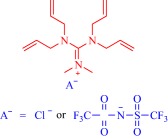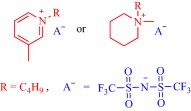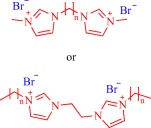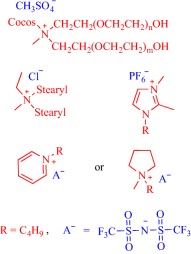Table 2.
Toxicity of some reported ILs to diverse life forms
| IL | Biosystem | Comment on toxicity |
|---|---|---|

|
Multicellular organisms: Daphnia magna, Pseudokirchneriella subcapitata, and Danio rerio. | In vivo, IL is toxic to test organisms.107 |

|
Multicellular organism: Galleria mellonella. | In vivo study suggested dependence of toxicity on length of alkyl chain.108 |
| Nucleic acid: Calf thymus DNA. | In vitro study showed helical conformation remains intact.109 | |

|
Multicellular organism: Mytilus galloprovincialis | In vivo tests showed lethal and nonlethal toxic effects.110 |

|
Prokaryotic cell: Vibrio fischeri, Pseudomonas fluorescens, Saccharomyces cerevisiae, E. coli, S. aureus, B. subtilis. | In vitro tests showed toxicity to all test organisms and in some cases more toxicity than common solvents such as benzene, chloroform, methanol.101 |

|
Eukaryotic cell: human colon carcinoma Caco‐2 cell. | In vitro tests reveal no toxic effects.41 |

|
Prokaryotic cell: V. fischeri. | In vitro studies showed toxicity to test organism. Branching increases toxicity.111 |

|
Enzyme, Eukaryotic cells, and multicellular organism: electric eel acetylcholinesterase, promyelocytic leukemia rat cells, Scenedesmus vacuolatus, Daphnia magna. | In vivo and in vitro studies indicated less toxic than monocationic ILs.103 |

|
Multicellular organism: Danio rerio | In vivo, ILs are toxic to test organism with the ammonium‐based IL being more toxic than imidazolium, pyridinium, and pyrrolidinium‐IL as well as other common solvents.112 |
